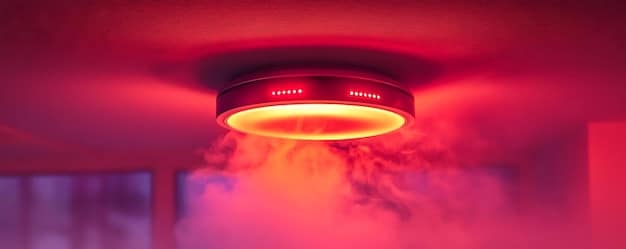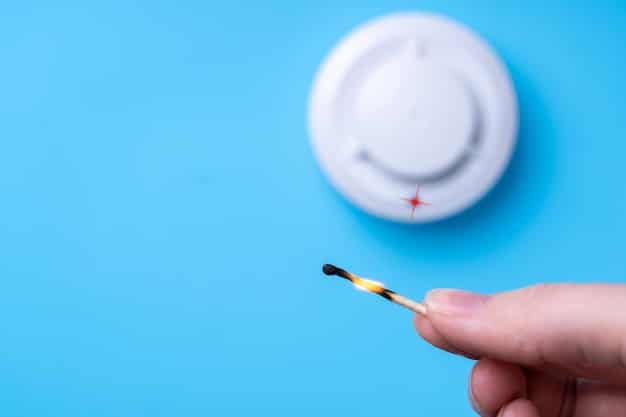Smart Smoke Detectors: Interconnected Alarms for Whole-Home Protection

Smart smoke detectors with interconnected alarms provide comprehensive home protection by ensuring that when one alarm is triggered, all alarms sound, offering early warning and potentially saving lives.
Protecting your home and loved ones from fire is a top priority. While traditional smoke detectors have served a purpose, smart smoke detectors: why you need interconnected alarms for whole-home protection offer a significant upgrade in safety and peace of mind.
Understanding Smart Smoke Detectors
Smart smoke detectors are advanced devices designed to detect smoke and fire, similar to traditional smoke detectors. However, they offer a range of additional features that enhance their effectiveness and provide greater convenience and control.
Key Features of Smart Smoke Detectors
Smart smoke detectors come equipped with various features that set them apart from conventional alarms. These features not only improve detection capabilities but also offer enhanced user experience.
- Interconnectivity: One of the main features of smart smoke detectors is that they can be interconnected. If one alarm detects smoke or fire, all the alarms in the house will sound, regardless of where the fire originates. This is particularly useful in large or multi-story homes.
- Mobile Alerts: Smart detectors can send real-time notifications to your smartphone or tablet. This means that even when you are away from home, you will be alerted to any potential dangers, allowing you to take swift action.
- Voice Alerts: Many smart smoke detectors feature voice alerts that provide specific information about the location of the fire. This can be especially helpful in guiding occupants to safety during an emergency.
- False Alarm Reduction: Smart detectors use advanced algorithms to minimize false alarms caused by cooking smoke or steam. They can differentiate between genuine threats and harmless triggers, reducing unnecessary disruptions.
Smart smoke detectors represent a significant advancement in fire safety. With features like interconnectivity, mobile alerts, and false alarm reduction, they offer a more reliable and convenient way to protect your home and loved ones.

The Importance of Interconnected Alarms
Interconnected alarms are a critical component of a comprehensive fire safety system. Unlike standalone smoke detectors, interconnected alarms communicate with each other, providing a synchronized warning throughout the entire home. This can make a significant difference in the outcome of a fire emergency.
Why Interconnectivity Matters
The primary benefit of interconnected alarms is that they ensure that everyone in the household is alerted to a fire, no matter where it starts or where they are located. This is especially important during nighttime hours when people are asleep.
Consider a scenario where a fire starts in the basement while you are asleep upstairs. A standalone smoke detector in the basement might sound, but you may not hear it through closed doors and multiple floors. With interconnected alarms, the alarm in the basement will trigger all the other alarms in the house to sound, waking you up and giving you valuable time to escape.
Benefits of Whole-Home Protection
Interconnected alarms provide comprehensive, whole-home protection. They ensure that every corner of your house is covered, reducing the risk of undetected fires and improving the chances of a safe escape.
Additionally, interconnected alarms can provide peace of mind knowing that your entire family will be alerted in case of an emergency, regardless of their location within the home. This can be particularly reassuring for families with children or elderly individuals.
How Smart Smoke Detectors Enhance Safety
Beyond basic detection, smart smoke detectors offer additional features that significantly enhance home safety. These features improve response times and provide more detailed information about potential threats.
The integration of smart technology in smoke detectors provides a layered approach to home safety. They ensure that not only are you alerted, but also that you receive the information needed to respond effectively.
Real-Time Mobile Alerts
One of the standout features of smart smoke detectors is their ability to send real-time alerts to your mobile devices. This means that you can receive notifications about potential fires, even when you are away from home.
Mobile alerts provide an extra layer of protection, allowing you to respond to emergencies remotely. For example, if you receive an alert while at work, you can contact the fire department or a neighbor to investigate. This can prevent a small fire from escalating into a much larger and more damaging event.
Voice Alerts and Location Identification
Many smart smoke detectors are equipped with voice alerts that provide specific information about the location of the fire. This is particularly useful in larger homes where it can be difficult to pinpoint the source of the alarm.
Voice alerts can guide occupants to safety by providing clear instructions and directions. For example, the alarm might announce, “Smoke detected in the kitchen,” allowing you to quickly assess the situation and take appropriate action.
Installation and Maintenance of Smart Smoke Detectors
Proper installation and regular maintenance are essential for ensuring that your smart smoke detectors function correctly. Following best practices can help maximize their effectiveness and prolong their lifespan.
Proper Placement of Smoke Detectors
The effectiveness of smoke detectors depends largely on their placement within the home. Strategic placement ensures early detection and minimizes the risk of undetected fires.
- Every Level: Install smoke detectors on every level of your home, including the basement.
- Inside and Outside Bedrooms: Place detectors inside each bedroom and just outside sleeping areas.
- Avoid Kitchens and Bathrooms: Do not install detectors in kitchens or bathrooms, where cooking smoke or steam can cause false alarms.
- Follow Manufacturer’s Instructions: Always follow the manufacturer’s instructions for proper placement and mounting.
Regular Maintenance and Testing
Regular maintenance is essential for ensuring that your smart smoke detectors are functioning correctly. Simple steps like testing and cleaning can go a long way in preventing malfunctions.
- Test Regularly: Test your smoke detectors at least once a month by pressing the test button.
- Replace Batteries: Replace the batteries in your smoke detectors at least once a year, or as recommended by the manufacturer.
- Clean Regularly: Use a vacuum cleaner to remove dust and debris from the detectors, which can interfere with their sensors.
- Replace Detectors: Replace smoke detectors every 10 years, as their sensors can degrade over time.

Choosing the Right Smart Smoke Detector
With numerous smart smoke detectors available on the market, selecting the right one for your home can be a daunting task. Consider these factors to make an informed decision and ensure you get the best protection for your family.
Factors to Consider
When choosing a smart smoke detector, consider factors such as compatibility with other smart devices, battery life, and ease of use. This will help ensure that the detector meets your specific needs and preferences.
- Interconnectivity: Ensure that the detector can be interconnected with other alarms in your home.
- Mobile App: Look for a detector with a user-friendly mobile app that provides real-time alerts and controls.
- Battery Life: Consider the battery life of the detector and whether it uses replaceable batteries or a built-in rechargeable battery.
- Certification: Choose a detector that is certified by a recognized testing laboratory, such as UL or ETL.
Top Smart Smoke Detector Brands
Several reputable brands offer high-quality smart smoke detectors with advanced features. Researching different brands and models can help you find the best option for your home.
- Nest Protect: Known for its sleek design and advanced features, such as voice alerts and smoke/CO detection.
- First Alert Onelink: Offers interconnectivity and mobile alerts, with options for both battery-powered and hardwired models.
- Kidde Smoke + Carbon Monoxide Alarm: Provides both smoke and carbon monoxide detection, with voice alerts and interconnectivity.
The Future of Home Safety with Smart Detectors
As technology continues to advance, smart smoke detectors are poised to play an even greater role in home safety. Future innovations may include enhanced sensor technology, AI-powered threat detection, and integration with other smart home systems.
The integration of smart technology is revolutionizing the way we protect our homes. By staying informed about the latest advancements and investing in smart smoke detectors, you can create a safer and more secure environment for your family.
Emerging Technologies
The future of home safety is likely to include even more advanced technologies that integrate with smart smoke detectors. This includes improved AI, enhanced sensors, and seamless integration with other smart home systems.
- AI-Powered Threat Detection: Future detectors may use artificial intelligence to analyze sensor data and identify potential threats with greater accuracy.
- Enhanced Sensor Technology: New sensor technologies could improve the detection of different types of fires and reduce false alarms.
- Smart Home Integration: Seamless integration with other smart home systems, such as smart thermostats and security cameras, could provide a more comprehensive approach to home safety.
Smart smoke detectors represent a significant advancement in fire safety technology. By choosing interconnected alarms, homeowners can enhance protection, receive real-time alerts, and ensure the safety of their loved ones. As technology continues to evolve, these devices will become even more indispensable in creating a safer and more secure home environment.
| Key Point | Brief Description |
|---|---|
| 🚨Interconnectivity | All alarms sound when one detects smoke, ensuring full-home alert. |
| 📱Mobile Alerts | Receive notifications on your phone, even when you’re away. |
| 🗣️Voice Alerts | Voice prompts identify the location of the smoke or fire. |
| 🛡️False Alarm Reduction | Detectors minimize false alarms from cooking smoke and steam. |
Frequently Asked Questions
▼
Interconnected alarms ensure that if one detects smoke, all alarms sound, providing a quicker, more comprehensive alert throughout your home. Standalone alarms operate independently.
▼
Some smart smoke detector systems offer compatibility with existing alarms through add-on devices. However, full functionality is best achieved with complete smart systems.
▼
It’s recommended to test your smart smoke detectors monthly to ensure they are functioning correctly. Most models have a test button for easy testing.
▼
Most smart smoke detectors provide a low-battery warning, often via a chirping sound or a mobile notification, giving you ample time to replace the batteries.
▼
Yes, smart smoke detectors offer enhanced safety features like remote alerts, voice prompts, and interconnected alarms, making them a worthwhile investment for your family’s safety.
Conclusion
Investing in smart smoke detectors: why you need interconnected alarms for whole-home protection is a proactive step towards enhancing your family’s safety. These devices offer advanced features that provide early warnings and improve response times, ensuring a safer and more secure home environment for everyone.





